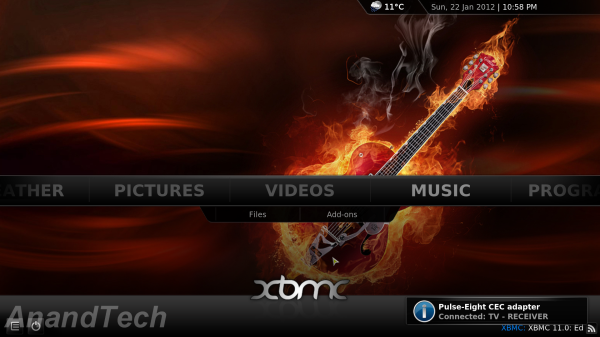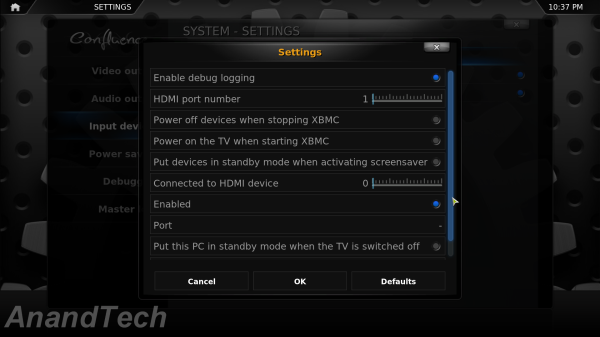Pulse-Eight USB CEC Adapter Review
by Ganesh T S on January 24, 2012 7:45 PM EST- Posted in
- Home Theater
- HDMI
- Pulse-Eight
- CEC
After the successful installation of the driver and the custom Eden build, I started up XBMC. The adapter was recognized in a few seconds and a helpful message popped up on the bottom right of the screen.
Navigating through System > Input Devices > Peripherals presented the Pulse-Eight CEC Adapter details. Various settings of the CEC adapter could be configured by selecting the peripheral.
It is essential that care be taken while setting 'HDMI port number' and 'Connected to HDMI device' in particular. The A/V receiver in our testbed, Pioneer Elite VSX-32 has a BD HDMI input, followed by HDMI1 through HDMI5. The HTPC setup was connected to HDMI1, which had to be indicated as Device 1 and not Device 0 in the settings for the 'Connected to HDMI device' field. The puzzling aspect was that CEC seemed to work even with the other setting. However, when the TV was turned off and on through the remote and the Sync Menu was later used to access XBMC on the HTPC (still running in the background), the receiver just shifted to the BD input and failed to deliver any picture to the display. I realized later that the two settings corresponded to the first two fields of the physical address that was discussed on the first page. Pulse-Eight would do well to just merge these two settings into one with valid inputs ranging from 1.0.0.0 to 13.13.13.13. In the current settings format, it appears that the CEC control scheme would choke if there were a couple of switches cascading through to the AVR and then onto the display, and the HTPC happened to be the farthest node from the display. Pulse-Eight informed us that the two settings would be made redundant in due course and the physical address automatically inferred through EDID detection. The current implementation also seems to reset the two address settings to default randomly between display power cycles / XBMC restarts. On this account, I am not too keen on automatic EDID detection and would rather let the end user have the ability to manually override the automatically deciphered settings.
The gallery below shows CEC in action in our testbed.
On the TV remote, the direction keys worked for basic menu navigation and selection. The Return key was used to go back to the previous screen, and the Display button was used to bring up the XBMC OSD as shown in the soccer screenshot in the above gallery. All in all, the ability to use the TV remote to control XBMC was pretty nifty and well worth the effort to get the CEC adapter up and running.
XBMC is not the only software capable of benefiting from the USB CEC adapter. Pulse-Eight also provides libCEC for download. It is a open source library designed for softwares to communicate with the USB CEC adapter. You can find more information about libCEC here. In this review, we chose not to cover libCEC in detail. libCEC makes a lot of sense for home theater integrators / home automation developers. In fact, any situation involving the need to reliably connect to the correct video source in a HDMI based system can benefit from libCEC. Apart from home entertainment, this includes video conferencing systems and Point of Sale control. But, detailed coverage of these types of applications is beyond the scope of this review. Coming back to HTPC applications, MythTV has already adopted libCEC in their unreleased 0.25 build.
















22 Comments
View All Comments
ganeshts - Thursday, January 26, 2012 - link
You need to get the wire out and also get the logic to read stuff on the wire / write onto it (this is where the Atmel microcontroller in the box comes into the picture). What is read and written is transferred through the USB port and controlled by libCEC / XBMC Eden built-in code.Malard - Thursday, January 26, 2012 - link
You are correct you could use our Internal Adapter (when it's released) and tap the CEC wire straight onto it, but the internal adapter relies on 3.3v constant power, which those mainboards supply, again, with enough soldiering you can rig any board to support CEC with the internal adapter, but its time vs reward, and you would be faster to just use the external adapterzilexa - Thursday, January 26, 2012 - link
Wich case is being used in this setup? I can only see the back in the picture. I am looking for a new case for my new HTPC and this one seems interesting. I am looking for a small one but they have a limited power supply (60-75 watt).ganeshts - Thursday, January 26, 2012 - link
zilexa, Please look up the specs of the Vision 3D 252B. It is ASRock's custom case and doesn't come with inbuilt PSU (there is a laptop power adapter sized unit delivering the power). Also, the case is pretty small, and I won't advise putting in CPUs of more than 45W TDP in there.Shadowmaster625 - Thursday, January 26, 2012 - link
I would love to be able to remote control my receiver. But there aint no way I'm paying those kinds of prices. lol. What is wrong with a simple RS232 serial port? It only costs a few bucks for USB to RS232 converter so you are covered even if your pc has no serial port. It is ubiquitous and pretty easy to program.ganeshts - Thursday, January 26, 2012 - link
That is a DIY solution :) and good luck getting it integrated all into XBMC. This is a OOTB answer to the home theater control issue.Monkeysweat - Thursday, January 26, 2012 - link
I got a question you might be able to answer,, at home I have a LG TV and a Samsung HTIB that has no HDMI inputs,,,both units are CEC capable but don't work with each other as missmatched brands,, however I can only plug my PC into the TV and the TV is connected to the HTIB by HDMI (receiver output to TV) and by optical cable (output from TV to receiver) - I have anything I play on my TV passthrough by optical output to the stereo as luck would have it, the TV allows DTS passthrough on HDMI
If i use the CEC adapter from the PC to TV,, would it be able to control the hometheater in a box connected on a different hdmi line?
Malard - Friday, January 27, 2012 - link
Yes, they are a unified bus, so long as all the hdmi wires connect via some device or other, be in the receiver or the TV then you will be fine.There is also no restriction as to where in the chain you connect the CEC Adapter
Monkeysweat - Friday, January 27, 2012 - link
sweeeeeeeeetwill this be made to work with raspberry pi as well? Kinda funny to buy an adapter that'll cost more than the device running it, but c'est la vie
Googer - Tuesday, January 31, 2012 - link
I suspect, It's not going to be long until nVIDIA and AMD both start implementing CEC in to their hardware and drivers. So devices like these may possibly become short lived.